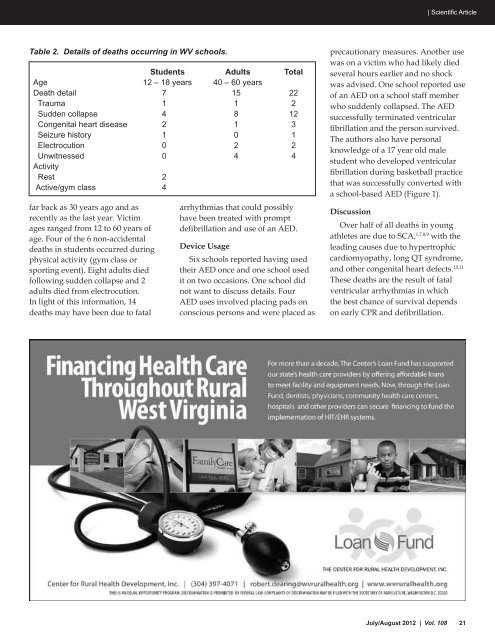Adam E. Klein, MD - West Virginia State Medical Association
Adam E. Klein, MD - West Virginia State Medical Association
Adam E. Klein, MD - West Virginia State Medical Association
Create successful ePaper yourself
Turn your PDF publications into a flip-book with our unique Google optimized e-Paper software.
| Scientific ArticleTable 2. Details of deaths occurring in WV schools.Students Adults TotalAge 12 – 18 years 40 – 60 yearsDeath detail 7 15 22Trauma 1 1 2Sudden collapse 4 8 12Congenital heart disease 2 1 3Seizure history 1 0 1Electrocution 0 2 2Unwitnessed 0 4 4ActivityRest 2Active/gym class 4far back as 30 years ago and asrecently as the last year. Victimages ranged from 12 to 60 years ofage. Four of the 6 non-accidentaldeaths in students occurred duringphysical activity (gym class orsporting event). Eight adults diedfollowing sudden collapse and 2adults died from electrocution.In light of this information, 14deaths may have been due to fatalarrhythmias that could possiblyhave been treated with promptdefibrillation and use of an AED.Device UsageSix schools reported having usedtheir AED once and one school usedit on two occasions. One school didnot want to discuss details. FourAED uses involved placing pads onconscious persons and were placed asprecautionary measures. Another usewas on a victim who had likely diedseveral hours earlier and no shockwas advised. One school reported useof an AED on a school staff memberwho suddenly collapsed. The AEDsuccessfully terminated ventricularfibrillation and the person survived.The authors also have personalknowledge of a 17 year old malestudent who developed ventricularfibrillation during basketball practicethat was successfully converted witha school-based AED (Figure 1).DiscussionOver half of all deaths in youngathletes are due to SCA, 1,7,8,9 with theleading causes due to hypertrophiccardiomyopathy, long QT syndrome,and other congenital heart defects. 10,11These deaths are the result of fatalventricular arrhythmias in whichthe best chance of survival dependson early CPR and defibrillation.July/August 2012 | Vol. 108 21















